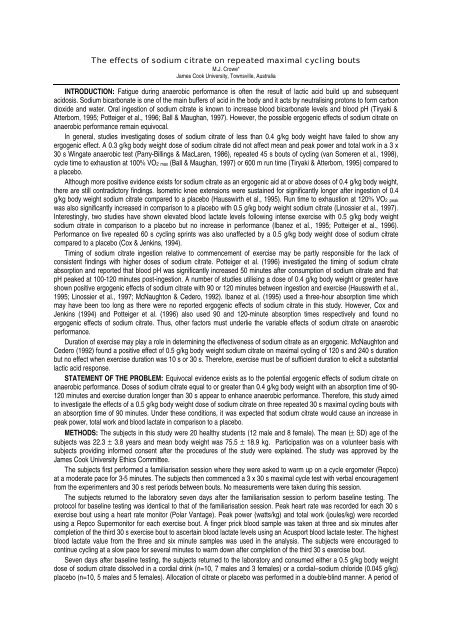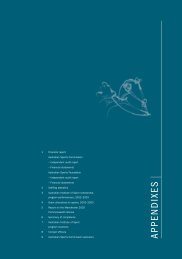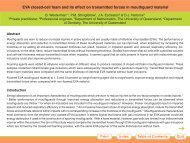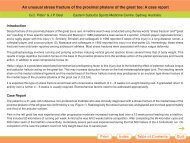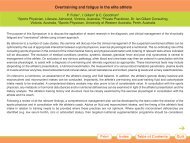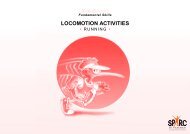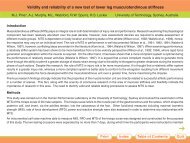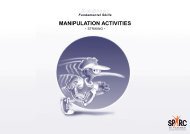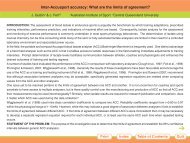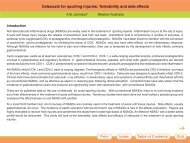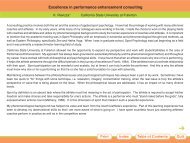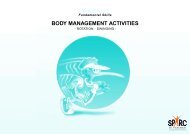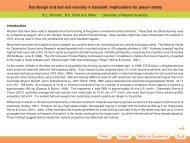The effects of sodium citrate on repeated maximal cycling bouts
The effects of sodium citrate on repeated maximal cycling bouts
The effects of sodium citrate on repeated maximal cycling bouts
Create successful ePaper yourself
Turn your PDF publications into a flip-book with our unique Google optimized e-Paper software.
<str<strong>on</strong>g>The</str<strong>on</strong>g> <str<strong>on</strong>g>effects</str<strong>on</strong>g> <str<strong>on</strong>g>of</str<strong>on</strong>g> <str<strong>on</strong>g>sodium</str<strong>on</strong>g> <str<strong>on</strong>g>citrate</str<strong>on</strong>g> <strong>on</strong> <strong>repeated</strong> <strong>maximal</strong> <strong>cycling</strong> <strong>bouts</strong><br />
M.J. Crowe*<br />
James Cook University, Townsville, Australia<br />
INTRODUCTION: Fatigue during anaerobic performance is <str<strong>on</strong>g>of</str<strong>on</strong>g>ten the result <str<strong>on</strong>g>of</str<strong>on</strong>g> lactic acid build up and subsequent<br />
acidosis. Sodium bicarb<strong>on</strong>ate is <strong>on</strong>e <str<strong>on</strong>g>of</str<strong>on</strong>g> the main buffers <str<strong>on</strong>g>of</str<strong>on</strong>g> acid in the body and it acts by neutralising prot<strong>on</strong>s to form carb<strong>on</strong><br />
dioxide and water. Oral ingesti<strong>on</strong> <str<strong>on</strong>g>of</str<strong>on</strong>g> <str<strong>on</strong>g>sodium</str<strong>on</strong>g> <str<strong>on</strong>g>citrate</str<strong>on</strong>g> is known to increase blood bicarb<strong>on</strong>ate levels and blood pH (Tiryaki &<br />
Atterbom, 1995; Potteiger et al., 1996; Ball & Maughan, 1997). However, the possible ergogenic <str<strong>on</strong>g>effects</str<strong>on</strong>g> <str<strong>on</strong>g>of</str<strong>on</strong>g> <str<strong>on</strong>g>sodium</str<strong>on</strong>g> <str<strong>on</strong>g>citrate</str<strong>on</strong>g> <strong>on</strong><br />
anaerobic performance remain equivocal.<br />
In general, studies investigating doses <str<strong>on</strong>g>of</str<strong>on</strong>g> <str<strong>on</strong>g>sodium</str<strong>on</strong>g> <str<strong>on</strong>g>citrate</str<strong>on</strong>g> <str<strong>on</strong>g>of</str<strong>on</strong>g> less than 0.4 g/kg body weight have failed to show any<br />
ergogenic effect. A 0.3 g/kg body weight dose <str<strong>on</strong>g>of</str<strong>on</strong>g> <str<strong>on</strong>g>sodium</str<strong>on</strong>g> <str<strong>on</strong>g>citrate</str<strong>on</strong>g> did not affect mean and peak power and total work in a 3 x<br />
30 s Wingate anaerobic test (Parry-Billings & MacLaren, 1986), <strong>repeated</strong> 45 s <strong>bouts</strong> <str<strong>on</strong>g>of</str<strong>on</strong>g> <strong>cycling</strong> (van Someren et al., 1998),<br />
cycle time to exhausti<strong>on</strong> at 100% VO2 max (Ball & Maughan, 1997) or 600 m run time (Tiryaki & Atterbom, 1995) compared to<br />
a placebo.<br />
Although more positive evidence exists for <str<strong>on</strong>g>sodium</str<strong>on</strong>g> <str<strong>on</strong>g>citrate</str<strong>on</strong>g> as an ergogenic aid at or above doses <str<strong>on</strong>g>of</str<strong>on</strong>g> 0.4 g/kg body weight,<br />
there are still c<strong>on</strong>tradictory findings. Isometric knee extensi<strong>on</strong>s were sustained for significantly l<strong>on</strong>ger after ingesti<strong>on</strong> <str<strong>on</strong>g>of</str<strong>on</strong>g> 0.4<br />
g/kg body weight <str<strong>on</strong>g>sodium</str<strong>on</strong>g> <str<strong>on</strong>g>citrate</str<strong>on</strong>g> compared to a placebo (Hausswirth et al., 1995). Run time to exhausti<strong>on</strong> at 120% VO2 peak<br />
was also significantly increased in comparis<strong>on</strong> to a placebo with 0.5 g/kg body weight <str<strong>on</strong>g>sodium</str<strong>on</strong>g> <str<strong>on</strong>g>citrate</str<strong>on</strong>g> (Linossier et al., 1997).<br />
Interestingly, two studies have shown elevated blood lactate levels following intense exercise with 0.5 g/kg body weight<br />
<str<strong>on</strong>g>sodium</str<strong>on</strong>g> <str<strong>on</strong>g>citrate</str<strong>on</strong>g> in comparis<strong>on</strong> to a placebo but no increase in performance (Ibanez et al., 1995; Potteiger et al., 1996).<br />
Performance <strong>on</strong> five <strong>repeated</strong> 60 s <strong>cycling</strong> sprints was also unaffected by a 0.5 g/kg body weight dose <str<strong>on</strong>g>of</str<strong>on</strong>g> <str<strong>on</strong>g>sodium</str<strong>on</strong>g> <str<strong>on</strong>g>citrate</str<strong>on</strong>g><br />
compared to a placebo (Cox & Jenkins, 1994).<br />
Timing <str<strong>on</strong>g>of</str<strong>on</strong>g> <str<strong>on</strong>g>sodium</str<strong>on</strong>g> <str<strong>on</strong>g>citrate</str<strong>on</strong>g> ingesti<strong>on</strong> relative to commencement <str<strong>on</strong>g>of</str<strong>on</strong>g> exercise may be partly resp<strong>on</strong>sible for the lack <str<strong>on</strong>g>of</str<strong>on</strong>g><br />
c<strong>on</strong>sistent findings with higher doses <str<strong>on</strong>g>of</str<strong>on</strong>g> <str<strong>on</strong>g>sodium</str<strong>on</strong>g> <str<strong>on</strong>g>citrate</str<strong>on</strong>g>. Potteiger et al. (1996) investigated the timing <str<strong>on</strong>g>of</str<strong>on</strong>g> <str<strong>on</strong>g>sodium</str<strong>on</strong>g> <str<strong>on</strong>g>citrate</str<strong>on</strong>g><br />
absorpti<strong>on</strong> and reported that blood pH was significantly increased 50 minutes after c<strong>on</strong>sumpti<strong>on</strong> <str<strong>on</strong>g>of</str<strong>on</strong>g> <str<strong>on</strong>g>sodium</str<strong>on</strong>g> <str<strong>on</strong>g>citrate</str<strong>on</strong>g> and that<br />
pH peaked at 100-120 minutes post-ingesti<strong>on</strong>. A number <str<strong>on</strong>g>of</str<strong>on</strong>g> studies utilising a dose <str<strong>on</strong>g>of</str<strong>on</strong>g> 0.4 g/kg body weight or greater have<br />
shown positive ergogenic <str<strong>on</strong>g>effects</str<strong>on</strong>g> <str<strong>on</strong>g>of</str<strong>on</strong>g> <str<strong>on</strong>g>sodium</str<strong>on</strong>g> <str<strong>on</strong>g>citrate</str<strong>on</strong>g> with 90 or 120 minutes between ingesti<strong>on</strong> and exercise (Hausswirth et al.,<br />
1995; Linossier et al., 1997; McNaught<strong>on</strong> & Cedero, 1992). Ibanez et al. (1995) used a three-hour absorpti<strong>on</strong> time which<br />
may have been too l<strong>on</strong>g as there were no reported ergogenic <str<strong>on</strong>g>effects</str<strong>on</strong>g> <str<strong>on</strong>g>of</str<strong>on</strong>g> <str<strong>on</strong>g>sodium</str<strong>on</strong>g> <str<strong>on</strong>g>citrate</str<strong>on</strong>g> in this study. However, Cox and<br />
Jenkins (1994) and Potteiger et al. (1996) also used 90 and 120-minute absorpti<strong>on</strong> times respectively and found no<br />
ergogenic <str<strong>on</strong>g>effects</str<strong>on</strong>g> <str<strong>on</strong>g>of</str<strong>on</strong>g> <str<strong>on</strong>g>sodium</str<strong>on</strong>g> <str<strong>on</strong>g>citrate</str<strong>on</strong>g>. Thus, other factors must underlie the variable <str<strong>on</strong>g>effects</str<strong>on</strong>g> <str<strong>on</strong>g>of</str<strong>on</strong>g> <str<strong>on</strong>g>sodium</str<strong>on</strong>g> <str<strong>on</strong>g>citrate</str<strong>on</strong>g> <strong>on</strong> anaerobic<br />
performance.<br />
Durati<strong>on</strong> <str<strong>on</strong>g>of</str<strong>on</strong>g> exercise may play a role in determining the effectiveness <str<strong>on</strong>g>of</str<strong>on</strong>g> <str<strong>on</strong>g>sodium</str<strong>on</strong>g> <str<strong>on</strong>g>citrate</str<strong>on</strong>g> as an ergogenic. McNaught<strong>on</strong> and<br />
Cedero (1992) found a positive effect <str<strong>on</strong>g>of</str<strong>on</strong>g> 0.5 g/kg body weight <str<strong>on</strong>g>sodium</str<strong>on</strong>g> <str<strong>on</strong>g>citrate</str<strong>on</strong>g> <strong>on</strong> <strong>maximal</strong> <strong>cycling</strong> <str<strong>on</strong>g>of</str<strong>on</strong>g> 120 s and 240 s durati<strong>on</strong><br />
but no effect when exercise durati<strong>on</strong> was 10 s or 30 s. <str<strong>on</strong>g>The</str<strong>on</strong>g>refore, exercise must be <str<strong>on</strong>g>of</str<strong>on</strong>g> sufficient durati<strong>on</strong> to elicit a substantial<br />
lactic acid resp<strong>on</strong>se.<br />
STATEMENT OF THE PROBLEM: Equivocal evidence exists as to the potential ergogenic <str<strong>on</strong>g>effects</str<strong>on</strong>g> <str<strong>on</strong>g>of</str<strong>on</strong>g> <str<strong>on</strong>g>sodium</str<strong>on</strong>g> <str<strong>on</strong>g>citrate</str<strong>on</strong>g> <strong>on</strong><br />
anaerobic performance. Doses <str<strong>on</strong>g>of</str<strong>on</strong>g> <str<strong>on</strong>g>sodium</str<strong>on</strong>g> <str<strong>on</strong>g>citrate</str<strong>on</strong>g> equal to or greater than 0.4 g/kg body weight with an absorpti<strong>on</strong> time <str<strong>on</strong>g>of</str<strong>on</strong>g> 90-<br />
120 minutes and exercise durati<strong>on</strong> l<strong>on</strong>ger than 30 s appear to enhance anaerobic performance. <str<strong>on</strong>g>The</str<strong>on</strong>g>refore, this study aimed<br />
to investigate the <str<strong>on</strong>g>effects</str<strong>on</strong>g> <str<strong>on</strong>g>of</str<strong>on</strong>g> a 0.5 g/kg body weight dose <str<strong>on</strong>g>of</str<strong>on</strong>g> <str<strong>on</strong>g>sodium</str<strong>on</strong>g> <str<strong>on</strong>g>citrate</str<strong>on</strong>g> <strong>on</strong> three <strong>repeated</strong> 30 s <strong>maximal</strong> <strong>cycling</strong> <strong>bouts</strong> with<br />
an absorpti<strong>on</strong> time <str<strong>on</strong>g>of</str<strong>on</strong>g> 90 minutes. Under these c<strong>on</strong>diti<strong>on</strong>s, it was expected that <str<strong>on</strong>g>sodium</str<strong>on</strong>g> <str<strong>on</strong>g>citrate</str<strong>on</strong>g> would cause an increase in<br />
peak power, total work and blood lactate in comparis<strong>on</strong> to a placebo.<br />
METHODS: <str<strong>on</strong>g>The</str<strong>on</strong>g> subjects in this study were 20 healthy students (12 male and 8 female). <str<strong>on</strong>g>The</str<strong>on</strong>g> mean (± SD) age <str<strong>on</strong>g>of</str<strong>on</strong>g> the<br />
subjects was 22.3 ± 3.8 years and mean body weight was 75.5 ± 18.9 kg. Participati<strong>on</strong> was <strong>on</strong> a volunteer basis with<br />
subjects providing informed c<strong>on</strong>sent after the procedures <str<strong>on</strong>g>of</str<strong>on</strong>g> the study were explained. <str<strong>on</strong>g>The</str<strong>on</strong>g> study was approved by the<br />
James Cook University Ethics Committee.<br />
<str<strong>on</strong>g>The</str<strong>on</strong>g> subjects first performed a familiarisati<strong>on</strong> sessi<strong>on</strong> where they were asked to warm up <strong>on</strong> a cycle ergometer (Repco)<br />
at a moderate pace for 3-5 minutes. <str<strong>on</strong>g>The</str<strong>on</strong>g> subjects then commenced a 3 x 30 s <strong>maximal</strong> cycle test with verbal encouragement<br />
from the experimenters and 30 s rest periods between <strong>bouts</strong>. No measurements were taken during this sessi<strong>on</strong>.<br />
<str<strong>on</strong>g>The</str<strong>on</strong>g> subjects returned to the laboratory seven days after the familiarisati<strong>on</strong> sessi<strong>on</strong> to perform baseline testing. <str<strong>on</strong>g>The</str<strong>on</strong>g><br />
protocol for baseline testing was identical to that <str<strong>on</strong>g>of</str<strong>on</strong>g> the familiarisati<strong>on</strong> sessi<strong>on</strong>. Peak heart rate was recorded for each 30 s<br />
exercise bout using a heart rate m<strong>on</strong>itor (Polar Vantage). Peak power (watts/kg) and total work (joules/kg) were recorded<br />
using a Repco Superm<strong>on</strong>itor for each exercise bout. A finger prick blood sample was taken at three and six minutes after<br />
completi<strong>on</strong> <str<strong>on</strong>g>of</str<strong>on</strong>g> the third 30 s exercise bout to ascertain blood lactate levels using an Acusport blood lactate tester. <str<strong>on</strong>g>The</str<strong>on</strong>g> highest<br />
blood lactate value from the three and six minute samples was used in the analysis. <str<strong>on</strong>g>The</str<strong>on</strong>g> subjects were encouraged to<br />
c<strong>on</strong>tinue <strong>cycling</strong> at a slow pace for several minutes to warm down after completi<strong>on</strong> <str<strong>on</strong>g>of</str<strong>on</strong>g> the third 30 s exercise bout.<br />
Seven days after baseline testing, the subjects returned to the laboratory and c<strong>on</strong>sumed either a 0.5 g/kg body weight<br />
dose <str<strong>on</strong>g>of</str<strong>on</strong>g> <str<strong>on</strong>g>sodium</str<strong>on</strong>g> <str<strong>on</strong>g>citrate</str<strong>on</strong>g> dissolved in a cordial drink (n=10, 7 males and 3 females) or a cordial–<str<strong>on</strong>g>sodium</str<strong>on</strong>g> chloride (0.045 g/kg)<br />
placebo (n=10, 5 males and 5 females). Allocati<strong>on</strong> <str<strong>on</strong>g>of</str<strong>on</strong>g> <str<strong>on</strong>g>citrate</str<strong>on</strong>g> or placebo was performed in a double-blind manner. A period <str<strong>on</strong>g>of</str<strong>on</strong>g>


